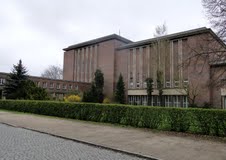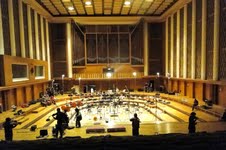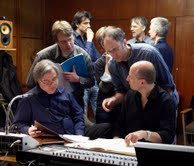
Järvi and Traugott: Crafting the Ideal in the Recording Studio
Situated on
the Spree River in run-down southeast Berlin, the Funkhaus Nalepastrasse is a
relic of the Soviet-era, a neglected, red-brick landmark designed by Bauhaus architect
Franz Ehrlich during the 1950s, formerly the headquarters of East German Radio. Judging by my entrance to the building – around
back, walking over a rock-strewn path amid rubble from adjacent buildings – it seemed
an unlikely venue for a recording session by an important German orchestra.

Because of
its superlative acoustics, however, the Grossen
Sendesaal in the Funkhaus, a handsome space with half columns at the sides,
has remained in continuous use since German re-unification in 1990. Daniel Barenboim recorded his Beethoven cycle
with the Staatskapelle Berlin there, and popular artists like Sting have also used
it.

The Grossen Sendesaal (“large broadcasting hall”) was the site of recording sessions by Paavo Järvi and the Deutsche Kammerphilharmonie Bremen for their much admired cycle of the nine Beethoven symphonies. It is also being utilized for their Schumann set, beginning with the release by Sony Classical of the first pairing, Symphonies No. 1 (“Spring”) and No. 3 (“Rhenish”).
Recording sessions are an inner sanctum – for good reason, considering the sensitivity of the process. This writer, a fly on the wall at the back of the control room, was allowed to witness the Schumann “Spring” Symphony sessions in April, 2010 to get a taste of what was described to me by veteran producer and recording company executive Günther Breest as “the most impressive experience I have had in the studio.”
Breest, long time producer for Deutsche Grammophon and retired president of Sony Classical, recommended the Funkhaus to Järvi and the DKB. Breest was a consultant for the orchestra from the late 1990s to 2009, lending them his influence and expertise during a difficult, transitional period. With Breest’s help, the DKB hired Järvi and embarked on their much admired Beethoven cycle. (Recording is a major incentive for Järvi, who went on to win the Deutsche Phono-Akademie’s ECHO Klassik Conductor of the Year Award for the DKB's Beethoven Symphonies No. 2 and 6 in 2010).
However, it was not just the Funkhaus and its fine acoustics that distinguished the “Spring” Symphony sessions. What came across most strongly was the recording process itself -- 17 hours spread over three days -- and the collaborative role played by the participants. The producer was Philip Traugott, senior producer for BMG Classics in New York from 1989-2000 (when BMG closed its New York office). A trained conductor and violinist, Traugott also produced the DKB’s Beethoven cycle. Sharing the control room with him were engineers Jean-Marie Geijsen and Dirk Fischer of Polyhymnia, an independent recording company based in The Netherlands.
“With Sony Classical, I have hired a lot of exquisite producers and I have done the job myself,” said Breest, who observed Traugott throughout the DKB Beethoven sessions. “I worked with Deutsche Grammophon with maestro (Herbert) von Karajan and producer Michel Glotz. This was my ideal team of conductor/producer until I experienced the work of Paavo with Philip.”
Järvi and Traugott are old friends, having met as conducting students at a Conductor’s Guild workshop in Morgantown, West Virginia in 1987. They had never recorded together until the DKB Beethoven cycle (to avoid spoiling an old friendship, said Traugott). Traugott and Järvi share responsibilities in the recording studio in an unusual and doubtless unique way. In effect, Traugott rehearses the orchestra and Järvi conducts performances. Traugott calls this “the best of both possible worlds,” a “creative process” that combines the greatest possible accuracy and artistry. “That’s our ultimate goal, to have recorded performances at the highest possible artistic level so that the listener can hear the closest thing to an ideal performance that we imagine the composer had in mind.”
From the control
room in the Funkhaus – a converted office space out of sight of the recording
hall except via TV monitors –Traugott called the takes through a
"talk-back" system, whereby a set of speakers was embedded in the
orchestra. Between takes he spoke directly to the musicians (with Järvi's
tacit approval), it being his role to address specific technical matters like
ensemble, intonation and balance with soloists or various groups in the
orchestra.
"The way Paavo and I have of working is that I get the orchestra into a white hot pitch so that they are able to perform the next take with as much accuracy as possible. He can keep his mind on the musical stuff and is ready to pounce the minute I‘m finished doing my corrections. He hasn’t had to get out of focus and into the ‘late 8th note,’ ‘balance-the-horns’ thing” Traugott said. “It’s also a little bit of the good cop/bad cop situation, where Paavo doesn’t have to directly criticize the performance of the players of the orchestra which helps keep morale up during this taxing work.”
After rehearsing or refining details in a particular section, Traugott passed the ball back to Järvi, usually with a wry comment like “now let’s make some music” or “give us some charm and magic.” (They may then “cover” (record) the section with either smaller patches or longer sweeping takes.) In his respective role, Järvi was "the visionary, the galvanizer and the inspirer" said Traugott. “He exerts a tremendous amount of energy, forward momentum and character into the music. That’s where his artistry completely takes over from and compliments what I’m doing.”
Such a procedure requires enormous trust and respect, said Breest. At the Beethoven sessions, Järvi was never “too proud to let go” and let Philip rehearse, he said. “He had no ego at this moment. He just sat back and let Philip work with each member of the Kammerphilharmonie, then he took over again and was able to have a tremendously well prepared team of musicians sitting in front of him.”The Schumann “Spring” sessions were remarkably cooperative and convivial on everyone’s part. The orchestra greeted Järvi at the first session by placing a spray of forsythia on his music stand. Traugott added a Slinky ("spring," a pun he had to explain to the German-speaking musicians) for amusing inspiration. The players in turn gave Traugott a bottle of wine and a chocolate bunny, the latter being a tradition “so I will be nice to them (during the recording),” he added. Lunches were taken in a huge foyer in the Funkhaus, and the players commuted by bus to and from their hotel in central Berlin for the twice daily recording sessions.
Järvi and
members of the Kammerphilharmonie crowded into the control room with Traugott
and the engineers to hear and comment on the playbacks, often during breaks. "The DKB is
deeply committed to the highest musical standard," said Traugott.
"Individual players offer honest and helpful feedback, raise important
questions and are also surprisingly quite self-critical during the entire
process."

Time, the bugaboo of unionized orchestras, is less of a factor for the DKB musicians, who have a self-governing structure. Still, Traugott was unfailingly respectful of their expectations. “I need to keep their trust,” he said. “If the session has a break at 4 p.m., they’re getting a break at 4 p.m., not 4:10 or 4:03. If they give us until 6 o’clock, we stop at 6 and only in a dire situation, will we ask them to give us more, and usually they say yes.”
Traugott’s psychological and tactical skills helped focus the players’ energies (rehearsing the most difficult parts first, while they were fresh, was only the most obvious example). He never withheld a compliment when deserved -- “It’s hard to read a score with tears in your eyes,” he said of an exquisite moment during the Larghetto of the “Spring” Symphony. And he was always ready with a “thank you, ladies and gentlemen.” His criticisms were usually painlessly oblique: “[Bassoonist X] is making a beautiful sound, but there’s too much of it.” As for humor, “You and Elke can do it as much as you want,” he said to Järvi and French hornist Elke Schulze Höckelmann of a dramatic moment during the finale.
“It took a while for the orchestra to realize that each of these recording sessions was a master lesson in orchestra training,” said Breest. “They came out better than they went in, and they began to like it tremendously. It was not work for them. It was aiming for a mutual goal, which is (a) very, very unusual (way of) working in the record industry.”